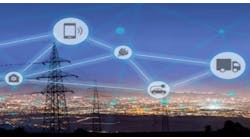How decentralized energy can be central to a smart manufacturing strategy
Consider decentralized energy like reshoring—moving energy-production centers closer to where that energy is consumed. Here we chat with Rohan Kelkar, EVP for Schneider Electric’s global power products division, at to learn how and why this approach is trending...and who can most benefit.
Take a look…
Smart Industry: How do you define decentralized energy? How does this differ from traditional energy tactics? Describe the adoption of this approach globally?
Rohan: In short, decentralized-energy systems refer to the relocation of energy production facilities closer to the source of energy consumption. These systems enable combined heat and power into renewable-energy sources, which decreases the need for fossil fuels and improves environmental efficiency.
The traditional approach to electrification, or electricity generation, is that you have a big utility at one point, and somewhere in the location could be whatever source of power generation—nuclear, gas, steam or hydro. Then that electricity is passed over a large grid and to an end-point distribution network. It's generally referred to as a one-directional flow, since electricity is generated in one place and consumed in another.
With decentralized energy, we see a transition from one-directional grids to bi-directional grids. This shift has led to the point of generation moving much closer to the point of consumption. However, more hybrid electrical infrastructures are coming into play; this is when the bulk of your facility is still powered traditionally. Still, you have a prevalence of primarily electric loads, enabling you to adopt a more closed load with energy-storage solutions.
The high cost is one of the biggest obstacles in utilizing energy-storage solutions for a global, decentralized energy grid. Right now, decentralized energy-storage solutions are expensive, preventing the concept's mass proliferation.
Smart Industry: What role does decentralized energy play in the digital transformation of manufacturing?
Rohan: About a third of the carbon footprint in industry is driven by the machinery used in factories, like motors and big furnaces—this is inherently inefficient because it runs at partial load. With the support of connected devices, industrial automation is already taking off in factories and putting us all on the path to Electricity 4.0. The concept behind this movement is that if something runs on electricity, it can be better controlled. For example, in the UK, gas is becoming scarce, sparking a movement from gas to electric furnaces that can operate more efficiently and are significantly easier to control dynamically.
As such adoption of connected IoT devices continues to drive the electrification of factory lines, the more users will be able to fine-tune for efficiency across their ecosystem and optimize operations—and the best part is we can start the transformation now. There are applications for motors and machinery that already have replacements identified.
Smart Industry: What tools/techniques are at play with the digitalization of power distribution worldwide?
Rohan: Energy-management organizations are rapidly transforming their operations to meet the increasing global demand for reliable power. In the race to net zero, organizations are taking action in three steps:
1. Strategize: The first step is to determine the organization’s carbon footprint and identify energy consumption across different scopes. Using this information, organizations can create new strategies to figure out where you are and what goals you want to set for your organization. Creating measurable goals gives you a clear picture of what success will look like. What gets measured, gets done.
2. Digitalize: Integrating digital solutions into physical systems and equipment can significantly reduce carbon emissions and energy consumption. Digitizing electrification is a crucial step in your decarbonization journey, as it allows organizations to fine-tune their operations to increase efficiency.
3. Decarbonize: Implementing digitization strategies based on your organization’s energy consumption will increase efficiency and reduce emissions. Prioritize setting goals, driving and reporting progress, and collaboration to succeed on the path to decarbonization.
Smart Industry: What regions are front-runners with the decentralized-energy approach? Where does the US fit in?
Rohan: Europe, for multiple reasons, has been at the forefront traditionally. Decentralized-energy storage, at some point, was seen as a European thing because of the economics and the cultural aspects of adoption.
APAC is not far behind either. When you consider this a developed-economy problem, you see it increase in developing economies inside Asia. Singapore has a problem with the sea levels rising, so they need to do something; otherwise, in 10-15 years, their coastline is going to start disappearing. Places like Indonesia are thousands of islands, so they have a fundamental challenge with distributing electricity in this decentralized setup. You see the same thing in Bangladesh, and other places that don't have the resiliency inside their grid—decentralizing the grid and "islanding" is often the only option they have.
Much of the focus in the US has been on the coasts—California, the Northeast, and, interestingly, Texas—again driven by economics. But it's also partly due to a large group of Fortune 500 companies making pledges toward carbon neutrality. As part of the carbon pledge, the company has to decarbonize its entire ecosystem. So now it's starting to create some momentum inside the industry.
Smart Industry: Will the need for this tact become more pressing as worldwide energy needs increase/energy production becomes more complicated?
Rohan: It already is for multiple reasons. Experts predict the IT sector electricity demand will grow 50% by 2030. We do not have the time or the ability to invest in one-directional electrical infrastructure to meet that estimate. People often ask if that means we'll get rid of fossil fuels, but I contend that we need that fossil-fuel base to meet the expected demand. However, you still need all these other sources to supplement that. Depending on the utility, you have a situation where they need to have more sophisticated supply-demand management of all these.



